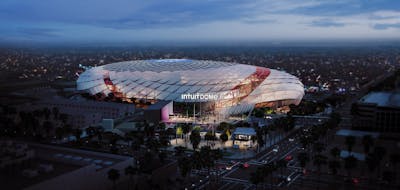
NRG Stadium
Texas-sized super stadium guns for third Super Bowl
Project Facts
| Location | Houston, Texas |
| Owner | Harris County Houston Sports Authority |
| Size | 1,900,000 SF |
| Cost | $360 million |
| Status | Completed 2002 |
| Capacity | 71,000 seats |
Overview
NRG burst on the scene to national fanfare on August 24, 2002, as the NFL’s largest stadium, and the first with an operable roof. At an area of 3.75 acres, it was also the largest such roof in the United States (at the time of its completion). The first portable grass field in the U.S. also came by way of NRG (which was converted to turf in 2016), and with 12,000 tons of cooling capacity, it’s one of the largest indoor air-conditioned spaces in Texas. Outside of multi-terminal airports, NRG is one of the largest public assembly spaces in Texas.
The adage that “everything is bigger in Texas” certainly applies.
Services
About the Project
Spanning more than 12 acres and comprising 1.9 million square feet, NRG Stadium has hosted two Super Bowls: Super Bowl LI in 2012, as the New England Patriots defeated the Atlanta Falcons, and Super Bowl XXXVII in 2004, the year of the infamous halftime wardrobe malfunction.
Home of the Houston Texans and the Houston Livestock Show and Rodeo, NRG sets a new standard for stadiums throughout the world. It is truly a super stadium.
The most distinctive feature of the stadium — the soaring operable roof — was also the most challenging. The enormous bi-parting panels abut over midfield, spanning 354 feet between supertrusses, are moved by a computerized system of electric motors. Several design and engineering innovations were incorporated, including unique stress relief detail and an electrical system allowing the roof to be quickly installed. An elaborate steel structural system had to be created to support this enormous roof, for which the construction had to be extremely precise. Lastly, the 2,000-ton roof wants to “fly away” under high winds, so a first-of-its-kind computerized clamping system was designed to hold it in its place. The translucent fabric roof creates an instant architectural landmark and a positive image for the City of Houston.
Fun Fact
In a bid to bring the Super Bowl back to Houston, NRG’s end zone displays were replaced with the largest digital displays in any professional sports venue and the second largest of their kind. Structurally engineered by Walter P Moore, the displays total 14,549 square feet.




